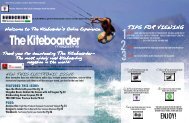Pimp Yo Kite - The Kiteboarder Magazine
Pimp Yo Kite - The Kiteboarder Magazine
Pimp Yo Kite - The Kiteboarder Magazine
Create successful ePaper yourself
Turn your PDF publications into a flip-book with our unique Google optimized e-Paper software.
<strong>Pimp</strong> <strong>Yo</strong> <strong>Kite</strong><br />
Connection Points: Most kites give you the option to tune the feel<br />
of the kite by changing the front or back line connection points. If<br />
you want the kite to respond slower, move your rear lines forward.<br />
This is especially helpful for wakestyle riders. If you look closely,<br />
you’ll see that most kites<br />
have at least two different<br />
connection points for your<br />
front lines. <strong>Yo</strong>ur kite will produce<br />
more power if you move<br />
your front lines back. Of<br />
course, this comes at a cost<br />
as the kite will be a little more<br />
sluggish since, for you aerodynamic<br />
junkies, it is running<br />
at a higher angle of attack,<br />
and generally it will be a little more difficult to go upwind. With<br />
some of the new hybrid kites, this change may be the difference<br />
between your kite being more bow styled (when you are on the<br />
forward connection) to acting a little more like a traditional C-kite<br />
(on the back setting). In this case, you won’t notice the negative<br />
effects mentioned of the aft setting.<br />
Kook Proof Connectors:<br />
Every kite should have kook<br />
proof connectors, not because<br />
you don’t know how to rig your<br />
lines, but because it’s easy to<br />
make mistakes when you are<br />
rigging your kite as fast as you<br />
can. <strong>The</strong>y are easy to make<br />
out of little pieces of spectra.<br />
Most common is to put knots<br />
at the end of your front lines<br />
and loops at the end of your<br />
back lines.<br />
44<br />
Fix the Holes: Check your kite<br />
for little nicks, scrapes, and<br />
holes. <strong>Yo</strong>u can fix anything under<br />
two inches long yourself. Leave<br />
anything over two inches for the<br />
professionals at the sail loft. Go<br />
buy some sail repair tape and<br />
always keep it with you. A tiny<br />
cut can become a huge tear if<br />
left alone. Place the tape on both<br />
sides of the kite, and round the<br />
corners of the tape to keep them from peeling off. If you don’t like<br />
white repair tape all over your kite, go buy a set of colored markers<br />
and color the tape to match your kite.<br />
Keep it Clean: Never put your<br />
sandy kite back in the bag. This is<br />
like throwing sheets of sandpaper<br />
in with it. Take it home, inflate it<br />
on the grass, and hose it down.<br />
Don’t put it in the bag until it<br />
is completely dry. A wet kite in<br />
the bag will produce mildew<br />
and mold. If you don’t want the<br />
colors to fade, spray 303 onto<br />
a sponge and evenly apply it to<br />
your canopy as needed. Don’t<br />
overdo it!<br />
Lube: If your kite has pulleys, go<br />
buy a can of McLube Sailkote.<br />
Keep your pulleys clean and<br />
spray them and the line that runs<br />
through them often. This will keep<br />
them working well and extend the<br />
life of your bridles.<br />
<strong>Pimp</strong> <strong>Yo</strong> Bar<br />
Make Sure <strong>Yo</strong>ur Lines are Even!<br />
People often forget that your lines<br />
shrink and stretch as they age. <strong>Yo</strong>u<br />
can’t drive a race car if it pulls to the<br />
right, and you sure as hell can’t learn<br />
tricks to blind when your kite is all<br />
over the place. <strong>Kite</strong>s are designed<br />
to fly with all lines the same length<br />
coming off the bar (that’s why those<br />
pigtails on your kite aren’t the same length on the leading and trailing edge).<br />
This is especially important when you have a 5th line bar, after a particularly<br />
windy session or when your gear is a year old. Make sure all lines are the<br />
same length, and then adjust the nose line on the kite so there is little to no<br />
tension. Tie your leash to a tree or other solid object and then hook the end<br />
of your lines to your leash clip. Grab the bar and pull lightly to make sure all<br />
or your lines are exactly the same length. Hooked up to the tree, it is easy<br />
to see if one line is coming slack sooner than the others. After you are done,<br />
hook up your kite and fly it at neutral. If properly balanced, your kite will sit<br />
steadily above your head without pulling either left or right.<br />
Stopper Ball: Add a stopper ball to<br />
your chicken loop above and maybe<br />
even below the bar. Putting a ball<br />
above the bar prevents it from getting<br />
away from you short armed riders.<br />
For those rippers killing it unhooked, it<br />
keeps the kite flying more like a fixed<br />
four line kite. If you get an adjustable<br />
ball or bar set-up, then it is easy to ad-<br />
just the amount of chicken loop in your setup so you can go from the waves<br />
(with lots of chicken loop play) to wake style on the flats. <strong>Yo</strong>u long armed<br />
apes may like a stopper ball below the bar (or a bigger harness loop). A ball<br />
below the bar will prevent the kite from oversheeting, even if you unhook.<br />
Simplify: Keep your bar simple and clean. If you still<br />
have a fixed loop on your bar, take it off (unless you ride<br />
a fixed bar). If you still use a shackle, get rid of it. <strong>The</strong><br />
use of the donkey stick makes shackles not necessary,<br />
plus shackles are goofy looking and can be dangerous.<br />
Shackles belong on sailboats, not kites.<br />
Can you reach? If you are short, you probably have<br />
to bend at the waist when you depower your kite. This<br />
is not good form. Change out your harness loop for a<br />
smaller one so you can keep your back straight, even<br />
when you depower. If you are really tall, you might<br />
want to get a longer harness loop, so you don’t look<br />
like T-Rex when you hold the bar in at full power. If you<br />
are short like Riccitelli, you can add extensions to your<br />
depower strap so you can reach it.<br />
Make ‘Em Last: If you make spectra pigtails for your<br />
lines, they will last twice as long. This will protect the<br />
sleeves from wearing through, and you probably need<br />
to buy spectra anyway to make kook proof connectors.<br />
Borrow a candle from your girlfriend and rub it on your<br />
chicken loop. <strong>The</strong> wax will protect the line from chafe.<br />
Don’t use surf wax. It will actually collect sand and<br />
make the line wear faster.<br />
Bucky Ashcraft shows us how<br />
to pimp yo ride with Texas pride.<br />
Lens: Ryan Riccitelli<br />
Tag It: Some people paint their kites to customize them. For<br />
example, Bucky Ashcraft painted a Texas Flag on his kite with<br />
acrylic spray paint. We do not know the long term affects, so<br />
please use at your own risk. As a minimum, you should definitely<br />
tag your name and contact information on your kite. A permanent<br />
marker works really well.<br />
45













